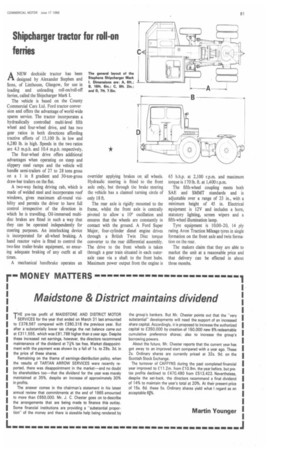Shipcharger tractor for roll-on ferries
Page 83

If you've noticed an error in this article please click here to report it so we can fix it.
ANEW dockside tractor has been designed by Alexander Stephen and Sons, of Linthouse, Glasgow, for use in loading and unloading roll-on/roll-off ferries, called the Shipcharger Mark I.
The vehicle is based on the County Commercial Cars Ltd. Ford tractor conversion and offers the advantage of world-wide spares service. The tractor incorporates a hydraulically controlled multi-level fifth wheel and four-wheel drive, and has two gear ratios in both directions affording tractive efforts of 15,100 lb. in low and 6,280 lb. in high. Speeds in the two ratios are 4.3 m.p.h. and 10.4 m.p.h. respectively.
The four-wheel drive offers additional advantages when operating on steep and slippery steel ramps and the vehicle will handle semi-trailers of 27 to 28 tons gross on a 1 in 8 gradient and 30-ton-gross draw-bar trailers on the flat.
A two-way facing driving cab, which is made of welded steel and incorporates roof windows, gives maximum all-round visibility and permits the driver to have full control irrespective of the direction in which he is travelling. Oil-immersed multidisc brakes are fitted in such a way that they can be operated independently for steering purposes. An interlocking device is incorporated for all-wheel braking. A hand reactor valve is fitted to control the two-line trailer-brake equipment, so ensuring adequate braking of any outfit at all times.
A mechanical handbrake operates an overrider applying brakes on all wheels, Hydraulic steering is fitted to the front axle only, but through the brake steering the vehicle has a claimed turning circle of only 18 ft.
The rear axle is rigidly mounted to the frame, whilst the front axle is centrally pivoted to allow • a 100 oscillation and ensures that the wheels are constantly in contact with the ground. A Ford Super Major, four-cylinder diesel engine drives through a British Twin Disc torque converter to the rear differential assembly. The drive to the front wheels is taken through a gear train situated in each outeraxle case via a shaft to the front hubs. Maximum power output from the engine is
65 b.h.p. at 2,100 r.p.m. and maximum torque is 170 lb. ft. at 1,400 r.p.m.
The fifth-wheel coupling meets both SAE and SMMT standards and is adjustable over a range of 23 in., with a minimum height of 45 in. Electrical equipment is 12V and includes a horn, statutory lighting, screen wipers and a fifth-wheel illumination lamp.
Tyre equipment is 10.00-20, 14 ply rating Avon Traction Mileage tyres in single formation on the front axle and twin formation on the rear.
The makers claim that they are able to market the unit at a reasonable price and that delivery can be effected in about three months.




















































































































































